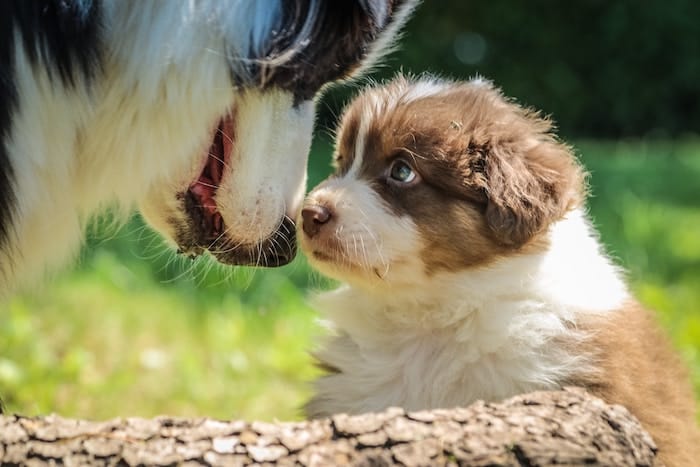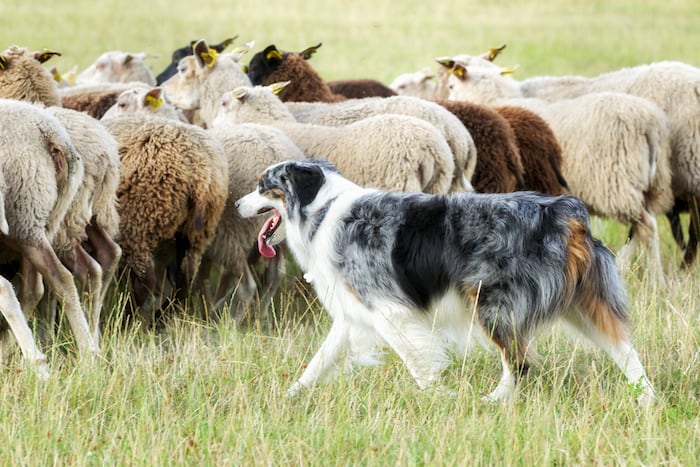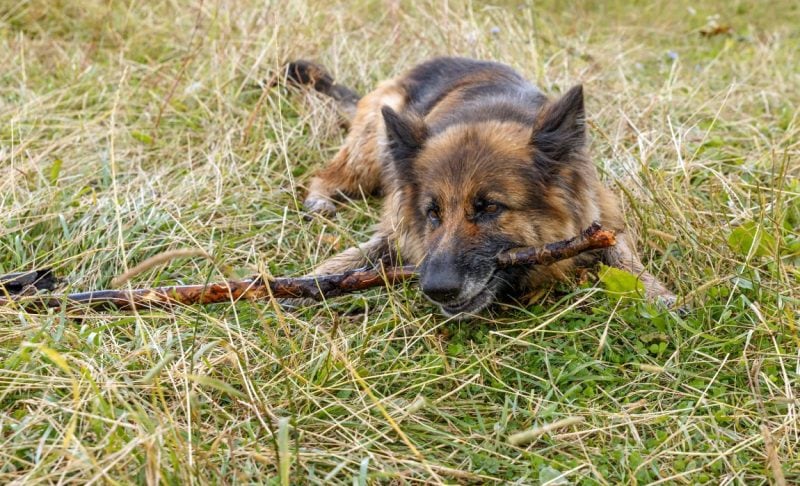When a dog bites a child, destroys his crate in the panic of separation anxiety, or growls over a toy, people almost always ask: is this nature or nurture?
Under the somewhat trite alliteration is a more serious question – can I fix or change my dog’s behavior? By how much?
As a dog behavior consultant, I get this question a lot. Almost as frequently, I hear assertions regarding whether a behavior is nature or nurture.
Several prominent dog training myths fall under the “nature versus nurture umbrella.”
- It’s all in how you raise them (all nurture).
- Puppies are a blank slate (all nurture).
- There are no bad dogs, only bad owners (all nurture).
- Dobermans/German Shepherds/Pit Bulls are inherently dangerous (all nature).
- He’s just a good dog. Not an aggressive bone in his body (all nature).
All of these sayings and sentiments, whether scary or comforting, aren’t quite true. We’ll break down each of these specific myths and misconceptions later on, but first let’s look at the broad truths of nature versus nurture in dogs.
How Heritable Is Temperament?
Temperament, personality, and behavioral tendencies are all passed on genetically. If the parents of your dog were skittish, your dog is more likely to be skittish, too.
But unlike things like eye color, temperament isn’t perfectly heritable. Environment (how you socialize, raise, and train your dog) can also have a big impact on your dog’s temperament.
There’s something called a heritability coefficient, which essentially outlines how much of a given trait is based on genetics.
For something like coat color, this is almost completely genetic. No matter how much I train my dog, his coat won’t change from black and white to brindle (unless I dye him).
We don’t know the exact heritability coefficient for coat color, but it’s probably extremely high (close to 100% heritable).
But there’s a lot more wiggle room for things like:
- tendency to like fetch
- tendency to herd sheep
- friendliness to other dogs
Your dog’s temperament is probably more like 40% genetics, 60% environment, or even less genetics and more environment!
Again, we don’t know specifically – and certain traits are probably more heritable than others. But the 40/60 split comes from 2017 research on how genetics influence behavior in dogs.
Unlike coat color, behavior and temperament is mostly “polygenic.” This means that your dog’s light-chasing obsession or adoration of other dogs can’t be pinned down to a single gene. It’s probably the interaction of several different genes, plus socialization, training, and other life experiences.
Basically – it’s a bit messy.

Learn more about dog genetics: How Many Chromosomes Do Dogs Have?
How Nature vs Nurture Factors Into Picking a Dog
When looking at bringing home a new dog, I find it helpful to always assume that everything I see is genetic. Everything about that dog is fixed, permanent, unchangeable – at least in the context of initially searching for my perfect canine companion.
This helps me get hyper-specific (and hyper-critical) about what I want and don’t want.
This also means that I turn down a lot of dogs that probably could have been great fits for my home with a bit of time and training.
When I adopted my current dog Barley, I skipped over dogs that shied away from me or weren’t interested in toys. I picked Barley because he was loose, waggy, and relaxed – until he got a toy. Then he was laser focused, a trainer’s dream. I assumed that what I saw is what I’d get, and I liked what I saw.
However, once a dog is in your home, blaming genetics for poor behavior isn’t very helpful. Once your dog is yours, it’s time to switch away from the genetic-based mindset and assume things are environment-based.
This change in outlook helps me search for creative solutions to unusual problems and keep focusing. This isn’t really the reality of your dog’s nature versus nurture, but the mindset shift is valuable.
This post-adoption environment-based outlook meant that when Barley started to bark and lunge at reflective things in low light (traffic cones were a particular problem), I didn’t just throw up my hands and say, “Oh well. He’s a Border Collie, they are jumpy and barky. I guess this is our life now.”
Instead, I grabbed my treats and started working on a training plan. Barley is probably a bit more sensitive to new things than your average Lab thanks to his genetics, but that doesn’t mean I had to throw in the towel just because he’s a Border Collie.
I start off with the genetic-based outlook when initially looking at dogs in order to set myself (and my dog) up for our best chance at success. We want to eliminate any obvious initial issues we can at the outset (because trust me, there will be other problems down the line).
Of course, this method is far from perfect.
Dogs in shelters are often stressed, which can result in them acting hyperactive or shut down, regardless of genetics It’s hard to get a good picture of your dog’s future behavior when she’s stressed out of her mind. And this is the biggest failure point when it comes to temperament tests.
Temperament Tests: Problematic, But They’re All We’ve Got
Many breeders and shelters offer temperament testing for their dogs and puppies, which are designed to give owners an assessment of their new potential dog’s ability to handle certain situations and stimuli
There are a huge variety of temperament tests out there. They’re a snapshot into the dog’s behavior based on nature and nurture up to that point, but they often are misconstrued as a nature-only view of how the dog will always be.
Unfortunately, even the best temperament tests aren’t very good at predicting future behavior in dogs.
These test are often conducted as a series of scenarios. For puppies, this might include:
- Separation from the litter
- Rolling the puppy on its back
- Opening an umbrella or dropping a pan nearby
For adult dogs, a test might include meeting a stranger, being handled for a mock veterinary exam, and meeting another dog.
The problem is that these tests are often increasingly stressful, almost provoking the dog into a response.
For example, a common test called the Match-Up II (the test we used at Denver Dumb Friends League while I was there) starts with a stressed-out shelter dog. It then takes the dog through a battery of exercises that get increasingly difficult, starting with simply petting and culminating in introducing the dog to a person with a cane, limping walk, funny hat, and sunglasses.
By the time the dog “meets” the “stranger,” it’s hardly a surprise that she’s often fed up and displays some unwanted fear or aggression!
Other food aggression tests basically look like a staff member harassing an eating dog until the dog snaps. Watch the video below and ask yourself if this is really a fair assessment of how “food aggressive” this dog actually is. The dog is practically being harassed until he is fed up!
You’d probably get annoyed pretty quickly if a weird hand kept trying to steal your dinner, too!
Another issue with temperament tests is that they can totally miss specific types of behavior. For example, many dogs are most aggressive if a stranger comes into their home – but you simply can’t test for that in a shelter environment.
One study found that 40.9% of dogs that passed a temperament test (meant to screen for aggression) at a shelter later displayed aggressive behavior like lunging, snapping, or biting. These dogs were evaluated using a modified version of Sue Sternberg’s temperament test.
Another study from Austria that tested puppies at 2-10 days old, 40-50 days old, and 1.5-2 years old found “little correspondence between individuals’ behaviour in the neonate, puppy and adult test.”
However, it’s worth noting that the Austrian researchers created their own temperament test for that study, so it’s unlikely that this test is what your breeder or shelter used.
It’s certainly true that some temperment tests still have value – the C-BARQ test has been shown to have predictive value for some behavioral traits according to a 2012 study. One study from the Animal Rescue League of Boston found that temperament tests have a roughly 43% predictive value.
The bottom line with temperament tests is that they can help when picking out a dog – but it would be foolish to blindly trust a temperament test.
When looking at adopting or purchasing a dog, it’s probably better to determine what you need in your dog, and then interview the people who know that dog best. Don’t put all your eggs in the temperment test basket!
Even at a busy shelter, there’s probably a kennel cleaner or intake staff who knows your dog who can give you far more information than a snapshot test!
The Myth of Nature “Versus” Nurture: It’s Both!
Whenever someone asks me if something is nature or nurture, my answer is almost always the same: it’s both.
The question shouldn’t be, “Nature or nurture?”
The question should be, “How much of this behavior can I change?”
Dogs (and humans, rats, dolphins, and every other animal) come with some predetermined wiring – their genetics. Genetics outline a dog’s size, shape, coloring, and behavioral tendencies.
That’s why we don’t see Huskies that herd sheep, or Greyhounds working as guide dogs.
It’s not that these dogs aren’t physically capable of the job – they are. But their behavioral tendencies make success at certain jobs much easier or harder.
- Huskies are much more likely to chase, bite, or grab the sheep than to gently guide them around using spatial pressure (herding).
- Greyhounds are notoriously fast and interested in chasing things, making them difficult to train for basic guide dog tasks (like holding things or opening doors) that Labs find relatively easy thanks to their history as retrievers.

Genetics plays a significant role, but after a puppy (or kitten, baby, or chick) is born, nurture starts to have a big impact. Life experiences, good or bad, can strongly affect how confident or fearful an animal is.
Whenever you’re frustrated with your dog’s training progress, it’s easy to blame things on nature. It’s also easy to get overly optimistic about things and assume that you can change everything in your dog. Try to be realistic and measured with your plans, goals, and expectations for your dog.
You’ll generally be much happier if you understand your dog’s underlying nature (genetics) and past experiences (nurture) and if you create stepwise plans for behavior change rather than just throwing up your hands and blaming genetics.
Nurture Can Change Nature – Science Makes Things Complicated
Of course, the line of where nature ends and nurture begins gets a bit fuzzier thanks to modern science.
The experiences of a parent can cause permanent changes in genes, which are passed on for generations (this is known as epigenetics).
So – what was the nurture of a parent can actually become the nature of the offspring!

There isn’t much research directly aimed at the epigenetics of dogs – so we have to extrapolate from human and mouse research.
Dr. Robert Sapolsky explains in his surprisingly accessible book Behave that the hormones in a mother’s mouse’s blood can impact the development and brain of a fetal animal. He points out that the hormones in her milk, too, can have an effect!
Stressful experiences or sicknesses for a mother dog can literally change how her puppies’ brains are wired.
Studies on rodents and pigs (see this literature review from 2002) show that where a fetus is in the womb relative to siblings and her pecking order within the litter can have an effect on how her brain wires as she grows.
Even a traumatic experience as an adult (like a dog fight) or ongoing stress can change DNA in mice, making an individual more hyper-responsive to stress and perceived threats.
Your dog’s gene expression will change as the develops from a two-celled embryo to the slobbery adult in your home.
This science blurs the line between nature and nurture, because it shows that nature can change your dog’s DNA – we can’t really draw a line in the sand and say “this side is nature, and this side is nurture” because ultimately, the two blend together.

Nearly imperceptible differences in your dog’s life can change her DNA, so while genetics can be helpful for identifying your dream breed, there’s really no guarantee any given dog will end up a certain way.
The Water Glass Analogy: How Genetics Interact With Environment
In my high school psychology class, I heard the best metaphor for nature versus nurture that I’ve heard yet.
My teacher drew a picture of two glasses of water on the board. Then he drew a blue line about ¼ of the way up one of them, and ¾ of the way up the other.
“Imagine that these blue lines depict the level of genetic risk that this individual has for a given trait – say, propensity towards anxiety.”
He then drew some red squiggles along the top of the glass, about two inches thick in each glass.
“Now imagine that this depicts the stress from a traumatic experience in that individual’s life. One of the glasses is now overflowing, right? So that individual is likely now experiencing serious anxiety, while the other individual is still doing ok.”

This is a good way to think of how our dog’s genetics can affect her temperament or behavior. Each individual dog is born with certain genetic predispositions to behavioral traits.
As the owner, you can modify the environment (via training or management) to prevent, reduce, increase, or eliminate behaviors. This is why the exact same training protocol can produce different results in different dogs!
Your dog may still be predisposed to certain behavioral issues or anxieties, but you have the power to stop your dog’s water glass from completely overflowing.
Debunking Misconceptions About Dog Temperament
Let’s leave the broad science behind for a moment and revisit some of the misconceptions from the beginning of this article.
Myth 1: It’s All In How You Raise Them
People love to look at a good dog and say with admiration, “It’s all in how you raise them.”
It’s meant as a compliment, but it’s just not true.
As we’ve already discussed, genetics have a significant influence over your dog’s behavior. Experiences in utero, in the whelping box, and moments outside of your control can also dramatically change your dog’s responses to the world.
What’s left is “how you raise them”, and sometimes there isn’t much room left in the water glass!
Genetic predisposition is part of the reason that Border Collies excel at herding while Labrador Retrievers tend to do well as guide dogs. Belgian Malinois make good guard dogs, whereas Papillons are excellent lap-warmers.
You could say that Border Collie’s have a “herding glass” that’s mostly full – all you have to do is give them the sheep. But no amount of sheep exposure will make most Papillons into stock dogs.

We’ve bred dogs for thousands of years with a purpose in mind. If temperament wasn’t hereditary, dog breeds would be just for looks (if they existed at all). But they’re not!
Of course, part of each breed’s success at a “job” is due to how you raise her. You can certainly raise a Papillon like a guard dog, and with a bit of training, she might even do well in the job. But she’ll never have the natural alertness and tenacity (and tendency to chase, bark, and bite) of a Malinois.
Genetics count.
Some dogs (like Trish McMillian Loehr’s pit bull Theodore, rescued from a dog fight bust) can go through unimaginable trauma and come out on the other end not only undamaged, but capable of helping other dogs through play. Theodore the pit bull was raised on a chain and was bred to fight other dogs. Yet he now travels the world helping rehabilitate other dogs with his owner.
His owner told me:
“Theodore was bred to fight, but he was rescued at 8 months, before he could be trained to fight. I somehow doubt he would be very good at it. There were young puppies at his bust who were already showing pretty severe dog aggression. His owner was good at breeding for it. Theo just didn’t get those genes.”
Compare Theodore to a litter of puppies that a good friend of mine produced. This friend is an experienced breeder who produces some of the best puppies around for her breed.
A few years ago, she hired a stud dog after painstaking research. The stud had beautiful bone structure, impeccable eyes and coat quality, and was a rockstar on the agility field. He was friendly to dogs and people and had excellent herding instinct.
But within a few weeks of the puppies being born, my friend could see something was wrong. Compared to her last litters of puppies, these little nuggets weren’t responding well to alone time, novelty, or other socialization. They were anxious, whiney, and quick to retreat and growl.

This experienced breeder was stumped. She gives her dogs the best possible care, with expensive and cutting-edge behavioral and medical support!
She soon found out that the stud dog actually had parents and siblings that were fearful and aggressive. Though the father himself was an amazing specimen, his relatives clearly carried some genetic baggage that was showing up in the puppies.
Some of the adult dogs from this litter are just as outstanding as their parents. Others are still fearful, quick to panic or bite, despite years of socialization and training at the hands of experienced trainers. These puppies had every advantage in life, yet they haven’t overcome their genetics to be calm, friendly, and well-adjusted dogs.
Theodore and my friend’s litter of puppies exemplify the extremes of how genetics can overcome environment, for better or for worse.
Myth 2: Puppies Are a Blank Slate
When I worked at Denver Dumb Friends, people constantly asked if we had more puppies up for adoption (we rarely had any available).
Aside from the cute factor, the biggest reason that people wanted a puppy was that they wanted a “blank slate.”
Of course, part of the advantage of adopting or purchasing a puppy is that you have much more control over your puppy’s socialization.
But as we’ve already discussed, puppies aren’t really blank slates. They come with genetics that determine temperament, in utero experiences that modify that, and neonatal experiences that change them even more.
If you sit down with a litter of five-week-old puppies (as I’ve had the joy of doing), you’ll notice that – even then – there’s variety within the litter. You can’t really just pick any old puppy and raise her how you’d like to get your dream dog.

Some puppies will be braver, sleepier, more barky, or more skittish than their siblings. Even at just a few weeks old, they have personalities already. Of course, this is probably both genetics and environment at work (is the shy one shy because he’s bullied by his fat brother?), but it just goes to show that at eight, ten, or twelve weeks old when they go home with you, puppies are not blank slates.
If puppies were truly blank slates, professional programs like Guide Dogs for the Blind wouldn’t have a roughly 50% “career change” rate. “Career change” canines are dogs who fail the training program to become full-time guide dogs.
Guide Dogs for the Blind has been breeding and raising service dogs for generations, only breeding the most qualified dogs who already meet a long list of criteria. Even still, 50% of the puppies they produce end up getting kicked out of the program and sent to other jobs.
These “career change” dogs generally are too excitable or too active to be the calm, cool, and collected guides for the blind. Many go on to become police or detection dogs instead. Most of those dogs who drop out of the Guide Dogs for the Blind program “fail” due to behavioral reasons.
Myth 3: There Are No Bad Dogs, Only Bad Owners
Just like “it’s all in how you raise them,” this sentiment can feel good.
It makes us feel like we’re in control of our dog’s behavior. It’s easier to blame the owner of an aggressive dog than it is to acknowledge that there might be other factors at work.
But saying that there are no bad dogs, only bad owners can make well-meaning owners feel like villains. An owner isn’t 100% responsible for her dog’s behavior and actions. At least some of each dog’s behavior is based off of her genetics.
Myth 4: Certain Breeds are Inherently Dangerous
Admitting that genetics plays such a significant role in a dog’s development seems to support the idea that certain breeds are inherently more dangerous than others – it’s in their genetics after all, right?
The thing is, most dog breeds (including Pit Bulls) aren’t actually bred for aggression anymore.
Even those that are bred for aggression can be raised, socialized, and trained in a way that helps mitigate their genetics.

There’s no denying that when you breed dogs with a specific temperament for generations, you’re more likely to get that temperament in the puppies.
But remember that genetics aren’t the whole story. We said above that behavioral traits 40% controlled by genes – or less.
So yes, some breeds might be more predisposed for suspicion of strangers, tendency to bite, or even aggression. And yet, there’s a lot of influence (60%) that’s not genetic at all. It’s likely that a good portion of a dog’s behavior is actually due to socialization and training.
Myth 5: He’s Just a Good Dog – Not an Aggressive Bone in His Body
A good friend said this to me repeatedly a few weeks ago. She was looking at her little Corgi with adoration.
Her sweet little Corgi had just finished barking and lunging at a man passing by in the dusk. While I agreed that he was scared more than aggressive, her statement made it seem like she was totally off the hook and could ignore warning signs.
If dogs truly came out with 100% predetermined behavior based on their genetics, we wouldn’t have to be so careful about socialization and training. We could just pick a friendly puppy and our work would be done.
In fact, all dogs can become fearful or aggressive with the right (or wrong) conditions.
Believing that your dog “could never” or “would never” do something because she’s “just a good dog” is nice – but it’s not true. Believing this can lead you to put blinders on, ignoring a problematic behavior because you aren’t able to see it as a warning sign.

Personality Characteristics: A Temperament Checklist for Your Dog
Personality types are poorly-defined for people – although we still love relying on tests like the Myers-Briggs, despite being debunked by most psychologists.
Things get even sketchier when we’re looking at dogs.
I don’t really like to think of broad “personality types” for dogs, and prefer to think of dogs as individuals with unique combinations of traits.
That said, a 2002 study narrowed down a battery of tests to predicting five major components of a dog’s personality. In theory, different combinations of these five factors could be considered personality types.
The researchers identified these five personality traits in dogs:
- Playfulness: A dog’s willingness to engage in tug-of-war and handler-directed play.
- Curiosity/Fearlessness: A dog’s startle reaction to sudden noise and interest in exploring a new room.
- Chase-proneness: A dog’s desire to follow or grab fast-moving objects.
- Sociability: A dog’s interest and friendliness towards a stranger, willingness to walk with a stranger, interest in playing with a stranger, and greeting of a person.
- Aggressiveness: A dog’s tendency to show any growling, barking, hair-raising, or other aggressive behavior during the test.
These five aspects of a dog’s personality are probably useful, but it’s always good to be cautious when looking at behavioral tests. When you’re trying to assess the temperament of a dog, it’s important to take everything with a grain of salt. A snapshot of behavior can always be “off.”
For example, my dog Barley is generally mildly interested in new people. But if you meet him on a day when he’s been cooped up for a bit too long, he’ll be over-the-top excited with new people. You might conclude he’s actually friendlier than he is.
Or you could surprise him in the dark when he’s already had a long day, and you’ll conclude he’s more aggressive than he is.

When creating a temperament test checklist, it’s important to include what’s important to you.
My friend with the Corgi really didn’t care if her dog loved toys or treats – he was just going to be a companion. She wanted a dog that could hang out alone while she was at work, then enjoy long walks after work.
But when I was looking for a new dog, I knew I wanted a dog with over-the-top love of toys and treats so that he could be a really awesome training partner.
If you’re looking at adding a new pup to your family, you might be interested in understanding where his behavior is at right now. This checklist won’t tell you which behaviors are going to be easily changed, but it can let you feel out where your dog is starting from.
Dog Personality Characteristic Checklist
Let’s look at some traits you can add to your dog’s personality characteristic checklist. Of course, it’s almost always better to ask someone who knows the dog how the dog reacts to these things “in general.”
Interest in chasing moving objects. Test this by tossing a toy.
Interest in playing tug. Test this by offering a tug toy to the dog.
Interest in putting things in their mouth. See if the dog is likely to pick up dropped or thrown objects.
Interest in strangers. Test this first by passing someone with the dog on a leash, then by having someone enter the room that you’re in.
Interest in other dogs. Test this by walking past another dog with your dog on leash. If possible, do an off-leash play test.
Recovery after a startling event. Test this by dropping something on the ground across the room from the dog. If the dog is already shy or scared, skip this one.
Interest in food. Offer the dog some treats and see how interested she is in them.
Problem-solving skills. Roll up some treats in a towel or shirt and see how the dog retrieves them.
Interest in training. Pick something simple, like eye contact, and reward the dog every time she does it. See how quickly she catches on and how long she plays the game with you.
Confidence on new surfaces. Put a grate, teeter-totter, or sheet of aluminum foil on the ground and see how the dog reacts to moving around it.
There are hundreds of other tests to see what your dog’s personality is like. Pick the ones that are most relevant to your life.
Most of us are looking for dogs that are interested in us, friendly with others, and relatively engaged in training and play. Over-the-top excitement, disinterest in training and play, major startle or fear responses, and outright aggression are almost always red flags.
Genetics and Environment: Both Play a Role In Your Dog’s Personality
The bottom line is that you may never know whether some aspect of your dog’s behavior is more because of genetics, in utero hormones, a scary experience when the puppy was 9 days old, or thanks to your current training regimen.
Your dog’s water glass comes with a certain bedrock of genetics. Understanding this can help you be more patient and realistic with training – but don’t blame your dog’s poor behavior on genetics if you haven’t spent some serious time building training plans and working through them.
Understand that your dog’s behavior is influenced by some things that you can’t change, but don’t let that stop you from coming up with training plans to achieve your goals. Just like your dog is a combination of nature and nurture, your relationship with your dog should be a combination of realism and strategic optimism!
Do you have a story of how you used training to overcome a genetic predisposition in your dog? We’d love to hear it – share your story or opinions in the comments!








Leave a Comment